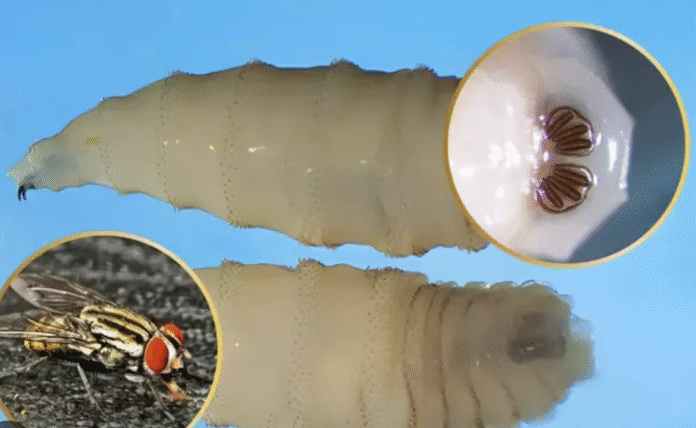Keypoints Summary – Stop Flesh Eating Maggots
- U.S. plans to Stop flesh eating maggots by releasing sterile flies
- Targeting New World screwworm invasive larvae
- Multimillion-dollar effort led by USDA and CDC
- Technique uses sterile insect release method
- Aims to protect livestock, pets, wildlife, and humans
- Flights start over high-risk zones along southern border
- Follow-up surveillance and rapid response teams on standby
- Larvae can burrow into living flesh — extremely dangerous
- Public warned about livestock checks and fly-proofing barns
- Success could eliminate screwworm threat permanently
Stop Flesh Eating Maggots With Sterile Fly Drops
The U.S. is taking dramatic action to stop flesh eating maggots—and the plan sounds straight out of science fiction. Authorities will drop millions of sterile New World screwworm flies from airplanes above southern states. The goal: stop a real invasion before it starts. This isn’t a drill. Screwworm larvae burrow into flesh, infecting animals and humans alike. Officials hope this bold tactic will crush any population before it reaches farms and communities.
What Are New World Screwworm Maggots?
These maggots aren’t your average nuisance. Screwworm larvae thrive in living flesh. They can infest cuts, wounds, even minor sores on animals or humans. Left untreated, they destroy tissue, cause sepsis and severe pain. Farmers know the horror stories—livestock lost overnight, animals suffering, ranchers bankrupt. A single baby sheep died this spring in Texas, raising red flags. The larvae were imported from Mexico, possibly hitching a ride on a stray dog. That tragedy triggered this emergency response.
How the Sterile Insect Technique Works
The solution? Fly bombs. Scientists rear sterile male screwworms in labs. These males mate with wild females—but produce no offspring. Over time, this shrinks the population. The method eradicated screwworms in the U.S. before—back in the 1980s. But this marks the first time the U.S. uses airborne releases on domestic soil. Millions of sterilized males will be dropped weekly from low-flying planes. The plan covers southern Texas, Arizona, and Florida—where sporadic fly outbreaks occurred previously.
Timeline and Strategy for Fly Drops
Drop missions begin next month and run through fall. Aircraft will pattern-drop flies above rural routes, ranches, and wildlife corridors. Each area receives targeted fly distribution every three days. Field teams will monitor traps and track egg-laying activity. If larvae are spotted, teams rush in with insecticides and quarantine zones. Professors say flies can’t cross the border indefinitely—this method buys time.
Impact on Livestock and Wildlife
The stakes reach farms, zoos, and national parks. In natural preserves, wildlife like deer and bison are vulnerable. In ranches, a single infected hog can cause a spreading outbreak. Economic losses could top $300 million if screwworms establish. This preemptive strike aims to protect animals—and the people who rely on them. It’s important to respond to the growing concerns about exotic pests entering through trade or migration.
Safety and Environmental Assurance
Critics might worry about dropping flies into communities. But officials stress these sterile flies don’t bite or spread disease. They aren’t dangerous. Experts also reviewed environmental impacts — and wildlife studies show no harm. Each dose is monitored by entomologists in the air and ground. The public is told to stay calm—and inspect pets and livestock daily for strange bumps or wounds.
Public Guidance and Preparedness
Residents in affected zones are urged to check animals daily. Visual inspections and wound care are key. Veterinarians will offer free screw-worm screenings at vet clinics. Barriers like fly screens and wound management help too. The USDA asks citizens to report suspicious larvae or unusual tickling sensations in flesh. Hotlines and quick response teams are ready to investigate reports.
Global Significance and Future Implications
If it works, the program will mark a major comeback for sterile insect technique. Crafting a national defense against invasive pests could inspire similar tactics for locusts, malaria-spreading mosquitoes, and other threats. The U.S. may send sterile fly teams south into Mexico and Central America if the invasion gains ground.
What Happens If It Fails?
Failure isn’t an option. A full-scale outbreak could devastate ranching communities, harm pets, and put humans at risk. Once screwworms gain foothold, control becomes costly and drawn out—possibly requiring biological operators and chemical warfare. Better to strike now—a million flies dropping from the sky—and prevent disaster.
Stop Flesh Eating Maggots
The plan to stop flesh eating maggots with millions of sterile flies is bold—and it’s happening now. This week marks a turning point in pest control.




